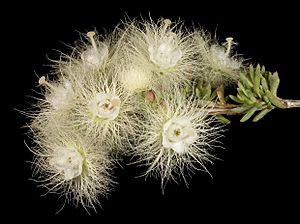Verticordia huegelii var. decumbens facts for kids
Quick facts for kids Verticordia huegelii var. decumbens |
|
|---|---|
 |
|
| Scientific classification |
|
| Kingdom: | Plantae |
| Clade: | Tracheophytes |
| Clade: | Angiosperms |
| Clade: | Eudicots |
| Clade: | Rosids |
| Order: | Myrtales |
| Family: | Myrtaceae |
| Genus: | Verticordia |
| Species: | |
| Varietas: |
V. h. var. decumbens
|
| Trinomial name | |
| Verticordia huegelii var. decumbens A.S.George
|
|
The Verticordia huegelii var. decumbens, also known as the variegated featherflower, is a beautiful flowering plant. It belongs to the myrtle family, called Myrtaceae. This plant only grows naturally in the south-west part of Western Australia.
It's a low-growing shrub, almost flat on the ground. Its flowers start as a creamy-lemon color. As they get older, they change to pink and then to red. This color change makes the plant look "variegated," meaning it has many different colors at once. This plant is similar to another type called Verticordia huegelii var. huegelii. However, the variegated featherflower has a special woody swelling underground called a lignotuber. This helps it survive fires.
Contents
About the Variegated Featherflower
Verticordia huegelii var. decumbens is a small shrub. It usually grows to be about 5 to 20 centimeters (2 to 8 inches) tall. It can spread out to be 30 to 50 centimeters (12 to 20 inches) wide. This plant has a special part called a lignotuber. This woody part grows underground and helps the plant survive bushfires. Sometimes, new shoots can also grow from its roots.
Its leaves are thin and shaped like a club. They are rounded on one side, about 3 to 6 millimeters (0.1 to 0.2 inches) long. They are only about 0.5 millimeters (0.02 inches) thick.
Flower Features
The flowers of this plant do not have a smell. They grow in round groups near the ends of the branches. Each flower sits on a small stalk that is 4 to 11 millimeters (0.16 to 0.43 inches) long. The base of the flower, called the floral cup, is about 2 millimeters (0.08 inches) long. It feels smooth but has some tiny hairs.
The sepals are like small leaves that protect the flower bud. They start as creamy-lemon and change to pink, then red as they age. They are about 7 to 8 millimeters (0.28 to 0.31 inches) long. They have many spreading hairs. The petals are similar in color to the sepals. They are mostly round, about 2 millimeters (0.08 inches) long and wide. They have a fringe of hairs around their edges.
The plant also has special parts called staminodes. These are shaped like a spear or an egg and have hairs at their tips. The style is straight and about 5 to 5.5 millimeters (0.20 to 0.22 inches) long. It has spreading hairs near its top and a cap-like tip. This plant usually flowers from September to November.
How it's Different
There are four types, or varieties, of V. huegelii. The decumbens variety is most like the huegelii variety. However, the decumbens type grows much lower to the ground. Its flowers are creamy-lemon, and the hairs on its style are spread out.
Plant Naming and History
The plant species, Verticordia huegelii, was first officially described in 1837. A scientist named Stephan Endlicher wrote about it. His description was published in a book about plants from Western Australia.
Later, in 1991, another scientist named Alex George studied the Verticordia group of plants. He identified four different varieties of Verticordia huegelii, including this one. The first example specimen, called the type specimen, was collected near Kelmscott in 1985. The second part of its scientific name, decumbens, describes how it grows. It means "decumbent", which refers to its low, sprawling habit.
Where the Plant Grows
This variety of V. huegelii likes to grow in sandy clay and gravel. This gravel often comes from granite rock. It is found in shrubland areas. You can find it in separate groups on the Darling Range. This area is between Mundaring and Williams. It also grows north of Badgingarra. These areas are part of the Avon Wheatbelt, Geraldton Sandplains, and Jarrah Forest biogeographic regions.
Protecting the Plant
The Western Australian Government's Department of Parks and Wildlife has looked at Verticordia huegelii var. decumbens. They have classified it as "not threatened." This means it is not currently in danger of disappearing.
Growing the Variegated Featherflower
This plant is quite easy to grow. You can start new plants from cuttings (small pieces of the plant) or from seeds. It is a tough plant and can handle some frost. It grows best in soil that drains water well, but not soil that is too sandy.

